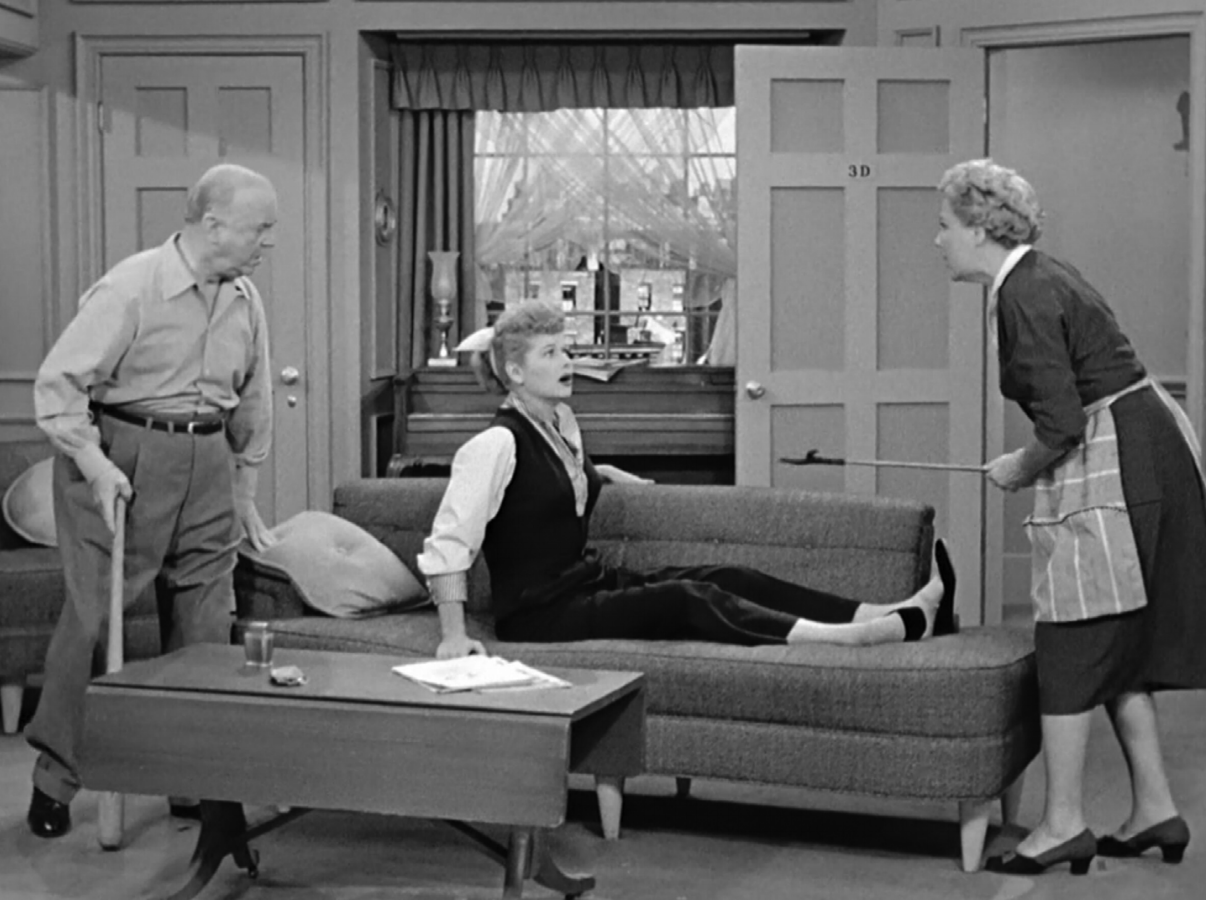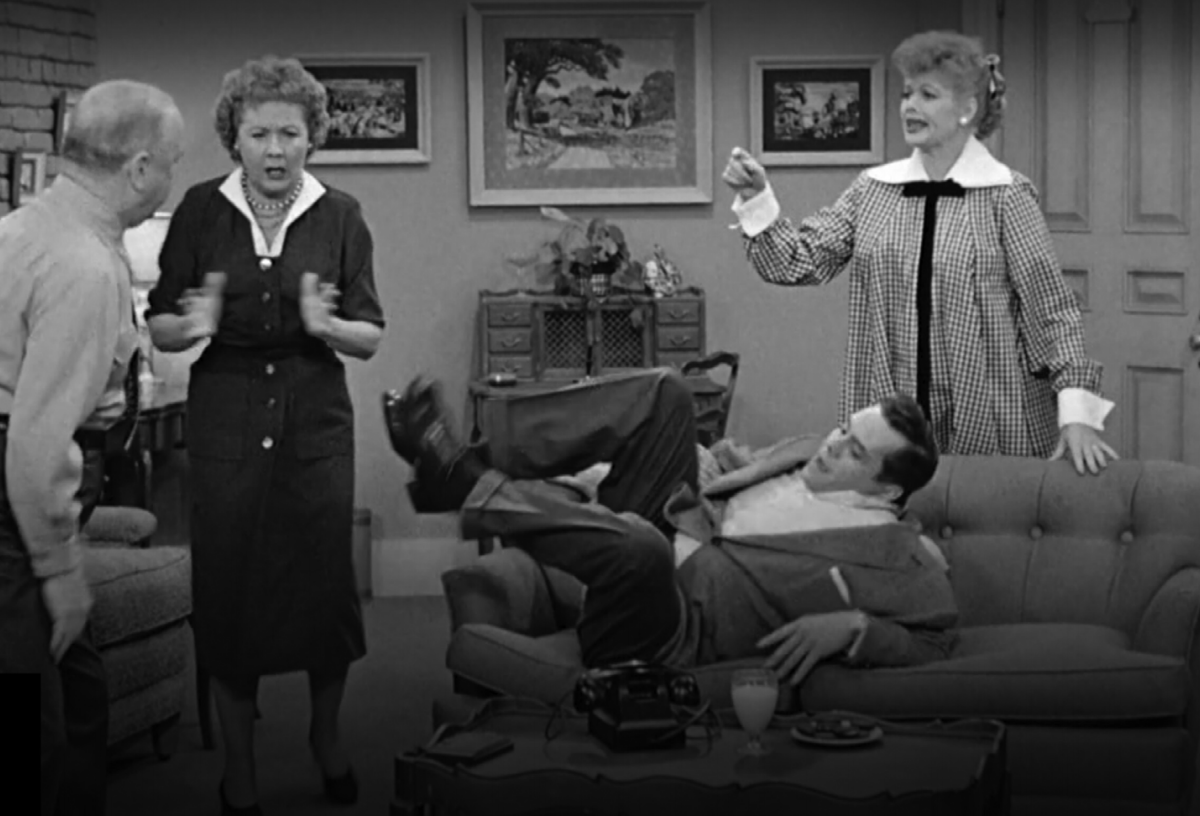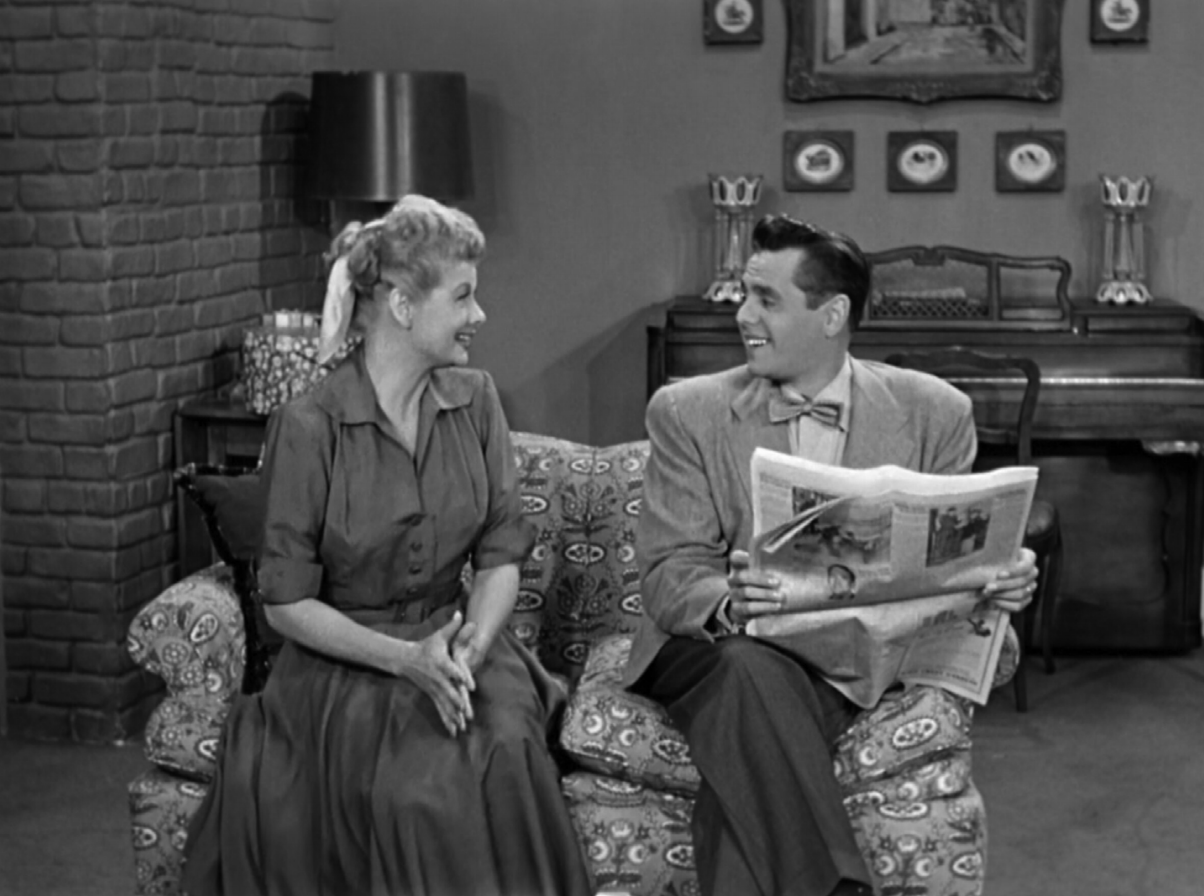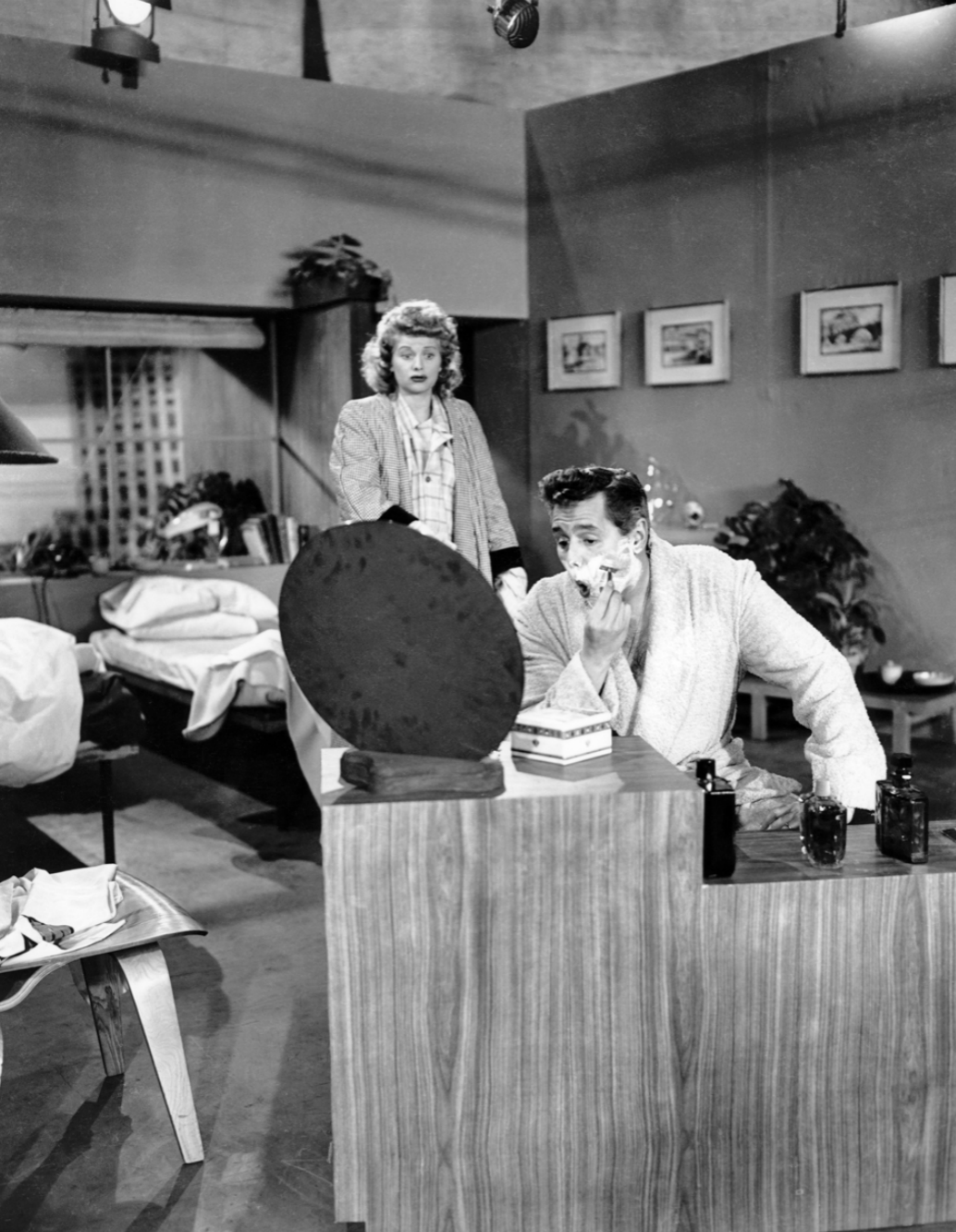I Love Lucy Apartment, Los Angeles, California (1951)
Artist/Designer: Glenda Rovello, Jess Oppenheimer
Project Location: California, United States





April 30, 1990 on CBS. ( Source | Accessed : March 5, 2021 )
Style/Period(s):
Postwar
Primary Material(s):
Wood, Glass, Fabric, Light, Paper, Textile, Wall Paper
Function(s):
Residential Structure
Related Website(s):
Significant Date(s):
20th Century, 1950-1959, 1951, 1950
Additional Information:
Publications/Texts in Print:
Kirkham, Pat, and Sarah Lichtman. “Furnishing I Love Lucy (1951-7).” Essay. In Screen Interiors: From Country Houses to Cosmic Heterotopias, 49–71. S.l.: AVA ACADEMIA, 2021.
Abreu, Christina D. Rhythms of Race: Cuban Musicians and the Making of Latino New York City
and Miami, 1940–1960. Chapel Hill: University of North Carolina Press, 2015.
Amato, Paul R. “Institutional, Companionate, and Individualistic Marriage: A Social
Psychological Perspective on Marital Change.” In H. Elizabeth Peters and Claire M. Kamp
Dush (eds.), Marriage and Family: Perspectives and Complexities, 75–90. New York: Columbia
University Press, 2009.
Andrews, Bart. “I Love Lucy.” New York: Doubleday and Company, Inc., 1976.
Andrews, Bart. Lucy & Ricky & Fred & Ethel: The Story of “I Love Lucy.” New York: E.P. Dutton &
Co., Inc., 1976.
Arnaz, Desi. A Book. New York: William Morrow and Company, Inc., 1976.
Andrews, Bart, The “I Love Lucy” Book (New York: Doubleday, 1976, 1985), 51.
Ball, Lucille (with Betty Hannah Hoffman), Love, Lucy (New York: Boulevard Books, 1996), 113.
Banks, Miranda J., "I Love Lucy: The Writer-Producer." In How To Watch Television, edited by Thompson Ethan and Mittell Jason, 244-52. NYU Press, 2013.
Butler, Jeremy Gaylord. Television: Critical Methods and Applications. 2nd ed. New York, NY: Routledge, 2012.
Carini, Susan M., “Love’s Labors Almost Lost: Managing Crisis during the Reign of ‘I Love Lucy,’” Cinema Journal 43, no. 1 (Autumn 2003): 47.
Fidelman, The Lucy Book, 54; Bart Andrews, Lucy & Ricky & Fred & Ethel (New York: Dutton, 1976), 205.
Firmat, Gustavo Pérez, The Havana Habit (New Haven, CT: Yale University Press, 2010), 129.
Kinchin, Juliet, “Interiors: nineteenth-century essays on the ‘masculine’ and the ‘feminine’ room,” in Pat Kirkham (ed.), The Gendered Object (Manchester, UK, and New York: Manchester University Press, 1996).
Koertge, Ron. "I Love Lucy." In Yellow Moving Van, 10-11. Pittsburgh, Pa.: University of Pittsburgh Press, 2018.
Spigel, Lynn. "Theorizing the Bachelorette: “Waves” of Feminist Media Studies." Signs 30, no. 1 (2004): 1209-221.
Asencio, Marysol (ed.). Latina/o Sexualities: Probing Power, Passions, Practices and Policies. New
Brunswick, NJ: Rutgers University Press, 2010.
Attfield, Judy. “Design as a practice of modernity: a case for the study of the coffee table in the
mid-century domestic interior.” Journal of Material Culture 2, no. 3 (November 1997): 267–89.
Ball, Lucille (with Betty Hannah Hoffman). Love, Lucy. New York: Boulevard Books, 1996.
Bennett, Mark. TV Sets: Fantasy Blueprints of Classic TV Homes. New York: TV Books, Inc.,
1996.
Butler, Jeremy G. Television: Critical Methods and Applications. 2nd edition. New York and
Abingdon: Routledge, 2012.
Butler, Jeremy G. Television Style. Abingdon and New York: Routledge, 2012.
Byrne, Terry. Production Design for Television. Boston and London: Focal Press, 1993.
Carini, Susan M. “Love’s Labors Almost Lost: Managing Crisis during the Reign of ‘I Love Lucy.’”
Cinema Journal 43, no. 1 (Autumn 2003): 44–62.
Castleman, Harry and Walter J. Podrazik. Watching TV: Four Decades of American Television.
New York: McGraw-Hill Book Company, 1982.
Connolly, Maeve. “Televisual Objects: Props, Relics and Prosthetics.” Afterall: A Journal of Art,
Context and Enquiry 33 (2013): 66–77.
Creadick, Anna G. Perfectly Average: The Pursuit of Normality in Postwar America. Amherst:
University of Massachusetts Press, 2010.
Cross, Gary. An All-Consuming Century: Why Commercialism Won in Modern America. New
York: Columbia University Press, 2000.
Czikzentmihaly, Mihaly and Eugene Rochberg-Halton. The Meaning of Things: Domestic Symbols
and the Self. Cambridge: Cambridge University Press, 1981.
Dalton, Mary M. and Laura R. Linder (eds.). The Sitcom Reader Second Edition: American
Re-Viewed, Still Skewed. Albany, NY: State University of New York Press, 2016.
de los Reyes, Vanessa. “I Love Ricky: How Desi Arnaz Challenged American Popular Culture.”
Masters thesis, Miami University, Oxford, Ohio, 2008.
Doty, Alexander. “The Cabinet of Lucy Ricardo: Lucille Ball’s Star Image.” Cinema Journal 29, no.
4 (1990): 3–22.
Fidelman, Geoffrey Mark. The Lucy Book: A Complete Guide to Her Five Decades on Television.
Los Angeles: Renaissance Books, 1999.
Friedman, Diana. Sitcom Style: Inside America’s Favorite TV Homes. New York: Clarkson Potter
Publishers, 2005.
Geraghty, Christine and David Lusted. The Television Studies Book. London: Edward Arnold,
1998.
Grier, Katherine. Culture and Comfort: Parlor Making and Middle-Class Identity, 1850–1930.
Washington, DC: Smithsonian Books, 1988.
Haralovich, Mary Beth and Lauren Rabinovitz (eds.). Television, History, and American Culture:
Feminist Critical Essays. Durham, NC, and London: Duke University Press, 1999.
Harris, Dianne. Little White Houses: How the Postwar Constructed Race in America. Minneapolis:
University of Minnesota Press, 2013.
Harris, Warren G. Lucy & Desi: The Legendary Love Story of Television’s Most Famous Couple.
New York: Simon & Schuster, 1991.
Hilmes, Michele (ed.). The Television History Book. London: BFI Publishing, 2003.
Horowitz, Susan. Queens of Comedy: Lucille Ball, Phyllis Diller, Carol Burnett, Joan Rivers, And the
New Generation of Funny Women. Amsterdam: Overseas Publishers, 1997.
Jones, Gerard. Honey, I’m Home! Sitcoms: Selling the American Dream. New York: Grove
Weidenfeld, 1992.
Kinchin, Juliet. “Interiors: nineteenth-century essays on the ‘masculine’ and the ‘feminine’ room.”
In Pat Kirkham (ed.), The Gendered Object, 12–29. Manchester, UK, and New York:
Manchester University Press, 1996.
Landay, Lori. Madcaps, Screwballs, and Con Women: The Female Trickster in American Culture.
Philadelphia: University of Pennsylvania Press, 1998.
Landay, Lori. “Millions ‘Love Lucy’: Commodification and the Lucy Phenomenon.” NWSA
Journal 11, no. 2 (Summer 1999): 25–47.
Landay, Lori. I Love Lucy. Detroit: Wayne State University Press, 2010.
Landay, Lori. “The Mirror of Performance: Kinaesthetics, Subjectivity, and the Body in Film,
Television, and Virtual Worlds.” Cinema Journal 51, no. 3 (Spring 2012): 129–36.
Lemaire, Isabelle. Cuban Fire: The Story of Salsa and Latin Jazz. New York: Continuum,
2002.
Lichtman, Sarah, and Pat Kirkham. Screen Interiors: From Country Houses to Cosmic Heterotopias. New York, NY: Bloomsbury Publishing, 2021.
Marc, David. Comic Visions: Television Comedy and American Culture. Boston: Unwin Hyman,
1989.
Marc, David. Demographic Vistas: Television in American Culture. Revised edition. Philadelphia:
University of Pennsylvania Press, 1996.
Marling, Karal Ann. As Seen on TV: The Visual Culture of Everyday Life in the 1950s. Cambridge,
MA, and London: Harvard University Press, 1994.
May, Elaine Tyler. Homeward Bound: American Families in the Cold War Era. New York: Basic
Books, 1988.
McClay, Michael. I Love Lucy: The Complete Picture History of the Most Popular TV Show Ever.
New York: Warner Books, 1995.
Mellencamp, Patricia. “Situation Comedy, Feminism, and Freud: Discourses of Gracie and Lucy.”
In Tania Modleski (ed.), Studies in Entertainment: Critical Approaches to Mass Culture, 80–95.
Bloomington and Indianapolis: Indiana University Press, 1986.
Mellencamp, Patricia. High Anxiety: Catastrophe, Scandal, Age and Comedy. Indianapolis: Indiana
University Press, 1992.
Molotch, Harvey. Where Stuff Comes From: How Toasters, Toilets, Cars, Computers and Many
Other Things Come to Be As They Are. New York and London: Routledge, 2003.
Oppenheimer, Jess (with Gregg Oppenheimer). Laughs, Luck . . . and Lucy: How I Came to Create
the Most Popular Sitcom of All Time. Syracuse, NY: Syracuse University Press, 1996.
Peacock, Steven and Jason Jacobs (eds.)., Television Aesthetics and Style. New York and London:
Bloomsbury Academic, 2013.
Pérez Firmat, Gustavo. Life on the Hyphen: The Cuban-American Way. Austin: University of Texas
Press, 1994.
Pérez Firmat, Gustavo. The Havana Habit. New Haven, CT: Yale University Press, 2010.
Robinson, Joyce Henri. “‘Hi Honey, I’m Home’: Weary (Neurasthenic) Businessmen and the
Formulation of a Serenely Modern Aesthetic.” In Christopher Reed (ed.), Not at Home: The
Suppression of Domesticity in Modern Art and Architecture, 102–10. London: Thames and
Hudson, Ltd., 1981.
Sanders, Coyne Steven and Tom Gilbert. Desilu: The Story of Lucille Ball and Desi Arnaz. New
York: Quill/William Morris, 1993.
Schlereth, Thomas J. Cultural History and Material Culture: Everyday Life, Landscapes, Museums.
Charlottesville, VA, and London: University Press of Virginia, 1992.
Silvato, Nick. “Big Glove: Televisual Dissociation and Embodied Performance.” Criticism 57, no. 1
(Winter 2015): 91–107.
Simmons, Christina. Making Marriage Modern: Women’s Sexuality from the Progressive Era to
World War II. New York: Oxford University Press, 2009.
Smith, Jacob. Vocal Trends: Performance and Social Media. Berkeley and Los Angeles: University
of California Press, 2008.
Spigel, Lynn. Make Room for TV: Television and the Family Ideal in Postwar America. Chicago and
London: University of Chicago Press, 1992.
Spigel, Lynn. Welcome to the Dreamhouse. Durham, NC, and London: Duke University Press,
2001.
Spigel, Lynn and Denise Mann (eds.). Private Screenings: Television and the Female Consumer.
Minneapolis: University of Minnesota Press, 1992.
Wilson, Kristina. Livable Modernism: Interior Decorating and Design during the Great Depression.
New Haven, CT, and London: Yale University Press in Association with Yale University Art
Gallery, 2005
Building Address: 846 Cahuenga Blvd., Los Angeles, California 90038
Tags: Film interiors, I Love Lucy, 1950s, 20th Century, Los Angeles, California, CBS
Significant Dates: Filming began in 1950, Show ran from October 15, 1951, to May 6, 1957
Viewers should treat all images as copyrighted and refer to each image's links for copyright information.